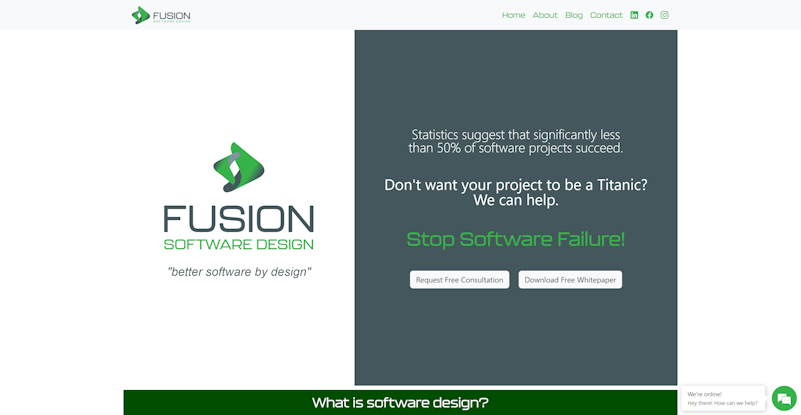Fusion Software Design

Details
About
Fusion Software Design is a dedicated provider specializing in the intricate process of software design. With a clear mission to enhance the success rate of software projects, Fusion emphasizes the importance of functional design, which serves as the foundation for creating effective and user-friendly applications. The company recognizes that a significant number of software projects fail to meet their objectives, and it aims to mitigate this risk through a structured and visual approach to design.
At its core, Fusion Software Design focuses on understanding the unique requirements of each project. This involves a comprehensive analysis of the client's needs, the expectations of end users, and the long-term vision for the software. By integrating experience and intuition into the design process, Fusion creates what it refers to as "functional design." This approach allows stakeholders—including clients, users, and developers—to visualize the intended form and function of the application before any coding begins.
Functional design is a term that encapsulates the meticulous process of outlining the complete flow of an application, screen by screen. Fusion employs various tools such as wireframes, mockups, and clickable prototypes to illustrate the full functionality of the app. This visual representation is crucial, as it provides clarity and direction for the development team, ensuring that everyone involved has a shared understanding of the project’s goals. Additionally, Fusion incorporates user testing and feedback loops into its design process, further enhancing the quality and usability of the final product.
One of the standout features of Fusion's approach is its emphasis on the power of visual design. While traditional requirements documents can be useful, they often fall short in conveying the nuances of a software project. By creating detailed blueprints for the application, Fusion reduces ambiguity and fosters more accurate bids from development teams. This clarity is akin to providing a detailed architectural plan for a building, which allows for precise execution and minimizes the risk of misinterpretation.
The benefits of functional design extend beyond just improved bidding accuracy. By establishing a clear design framework upfront, Fusion enables the development of a superior product. This proactive approach allows for a more seamless integration of features and functionalities, as potential challenges can be identified and addressed during the design phase. Consequently, this leads to a cleaner and more cohesive application, which can even be tested with end users prior to the commencement of coding.
Moreover, having a well-defined design in place empowers developers to make informed decisions throughout the development process. With a comprehensive understanding of the project's scope and objectives, developers can navigate challenges more effectively, resulting in higher quality and more maintainable code. This foresight not only streamlines the development process but also reduces the likelihood of extensive rewrites, which can be both time-consuming and costly.
Another significant advantage of Fusion's functional design approach is its ability to minimize scope creep. In many software development projects, unexpected features and requirements can emerge, leading to budget overruns and extended timelines. By establishing a clear design framework from the outset, Fusion helps to set realistic expectations and boundaries for the project. This proactive measure ensures that all stakeholders are aligned on the project's scope, ultimately leading to a more controlled and efficient development process.
User satisfaction is a critical component of any successful software project, and Fusion recognizes that usability is paramount. The company understands that software should be intuitive and easy to use, catering to the diverse needs of its users. By prioritizing functional design and incorporating user testing into the process, Fusion aims to create applications that resonate with users and enhance their overall experience. A well-designed application not only meets functional requirements but also fosters user engagement and satisfaction.
The clarity and structure provided by Fusion's pre-design process contribute to a more positive experience for all parties involved in a software project. When a project is well-defined and organized, it reduces the stress and uncertainty that often accompany software development. This clarity allows product managers, technical leads, developers, and end users to collaborate more effectively, ultimately leading to a successful project where everyone can take pride in their contributions.
Fusion Software Design is committed to bringing software projects to life with a focus on functional design. The team comprises individuals who are passionate about the art and science of software design, and they strive to ensure that each project not only meets but exceeds expectations. By offering a range of services, including full-resolution design mockups, digital assets, prototypes, architectural services, and technology stack consultation, Fusion provides a comprehensive suite of solutions tailored to the unique needs of each client.
In summary, Fusion Software Design stands out as a provider that prioritizes the importance of functional design in the software development process. By creating detailed blueprints and visual representations of applications, the company enhances communication, reduces ambiguity, and ultimately increases the likelihood of project success. With a commitment to user satisfaction and a structured approach to design, Fusion is dedicated to helping clients navigate the complexities of software development and achieve their goals. Through its innovative practices and focus on clarity, Fusion Software Design is poised to make a significant impact in the realm of software design, ensuring that projects not only come to fruition but thrive in their intended environments.
Not sure where to start?
Get help with your project during our free UX session
